Working conditions
Low wages
Poor working conditions
Worker complaints
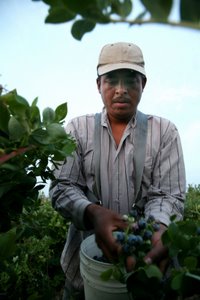 LAMONT, CA - 12JUNE09 - Migrant indigenous Mixtec farm workers from Oaxaca pick blueberries. Copyright David Bacon
LAMONT, CA - 12JUNE09 - Migrant indigenous Mixtec farm workers from Oaxaca pick blueberries. Copyright David BaconAs part of the Indigenous Farmworker Study we conducted an in-depth survey of 400 workers in 2008 which we call the Indigenous Community Survey (ICS). Although the ICS only reports data from nine hometown networks, it sheds light on wages and working conditions that we believe are representative for indigenous farmworkers as a whole. Our survey showed remarkably low wages for indigenous farmworkers. In 2008, two thirds of the indigenous farmworkers in the survey earned at the minimum wage or below. One third of the workers earned above the minimum wage ($8.00 per hour), one third reported earning exactly the minimum and one third reported earning below the minimum. When reviewing the descriptions of the wages and working conditions, one needs to remember that all of the groups (on average) are poorly paid and endure difficult treatment.
Like other farmworker surveys, this survey confirms that wages do not rise with age, nor much with the length of time spent in the United States. For example, in Chart 1 below, we see that newcomers average $7.50 while more experienced workers have only a modestly higher average at $8.25 per hour. In fact, after the indigenous workers have been in the country 5 years, wages appear to stagnate, reflecting the fact that, as a rule, experience is not rewarded with significantly higher wages in California’s fields.
The modest variation in wages among groups may not mean that working and living conditions are any better for those with the higher wages. As we discuss below, many times those with relatively higher hourly wages are working for a piece rate in a sped-up work environment with equally poor working conditions.
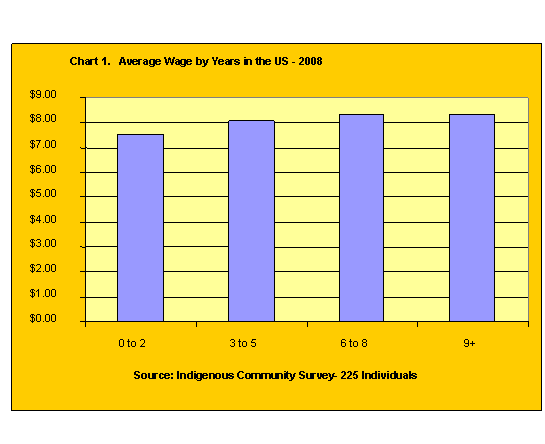
Although wages don’t vary much by age or time in the country, there are significant differences in wage levels among different crops and regions of California. The three main crop activities of the respondents in the Indigenous Community Survey were vegetables, grapes and field-fruit (mostly strawberries). A few workers reported working in citrus and tree fruit. Vegetables and grape workers reported earning slightly above minimum wages on average, while field-fruit, citrus and tree-fruit workers reported an average below the $8.00 per hour minimum (see Chart 2).
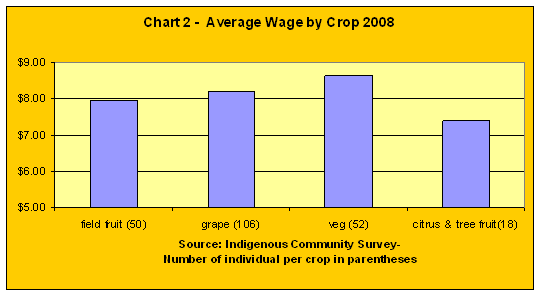
These higher wages by crop reflect regional differences. In Santa Rosa, indigenous workers have benefitted from the relatively high hourly wages in the local grape industry; and in Salinas workers have on average earned above the minimum because of the relatively high hourly wage paid in the vegetable industry. In all other areas, the average wage was at or below the minimum (see Chart 3, below). In general, workers in Santa Maria, Oxnard, and Watsonville worked in the relatively low-wage strawberry industry. In San Diego, workers worked in the low-wage strawberry and tomato crops, while in Bakersfield and Fresno grapes predominate.
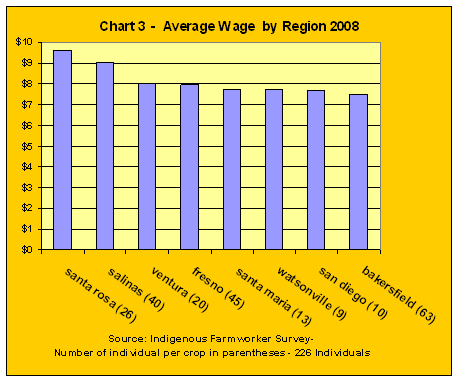
 SANTA MARIA, CA - 16FEBRUARY09 - Indigenous Mixtec and Zapotec farm workers from Oaxaca and Guerrero pick strawberries in the crew of foreman Eugenio Cardenas of the Central Coast company. The berries will be marketed by Green Giant. Workers bring the strawberries they've picked to the checker, who inspects the berries and then punches a ticket that keeps track of the number of boxes the worker has picked. Copyright David Bacon
SANTA MARIA, CA - 16FEBRUARY09 - Indigenous Mixtec and Zapotec farm workers from Oaxaca and Guerrero pick strawberries in the crew of foreman Eugenio Cardenas of the Central Coast company. The berries will be marketed by Green Giant. Workers bring the strawberries they've picked to the checker, who inspects the berries and then punches a ticket that keeps track of the number of boxes the worker has picked. Copyright David BaconAbove, we saw that wage levels were low and fairly uniform regardless of the age of the worker or time spent in the United States, though there were some significant variations by crop and by region. With respect to working conditions, we find they are uniformly poor for indigenous farmworkers, independent of wage level or region. Although it is hard to measure bad working conditions directly (using a survey such as ours), poor conditions are known to be associated with paying by the piece rate, requiring workers to pay for rides and charging workers for work equipment. We were able to inquire about these practices and so we use them as (indirect) indicators of poor working conditions.
Farm labor contractors (FLCs) are intermediaries who hire and supervise workers for growers who don’t want to hire and manage their workforce directly. Survey research over many years has clearly demonstrated that there is a close tie between farm labor contractors and poor working conditions but not with low wages. Interestingly, the FLC employees in the Indigenous Community Survey are paid virtually the same wage ($8.21 vs. $8.15) as those working directly for the growers. However, this equivalence in the wage is often associated with poorer working conditions for the FLC employees. As in other surveys, the Indigenous Community Survey shows that farm labor contractors, compared to growers who hire directly, more often pay by the piece rate (45% vs. 30%); they more often charge their workers for equipment (63% vs. 40%); and FLC employees more often pay for rides than those working directly for a grower (31% vs. 21%).
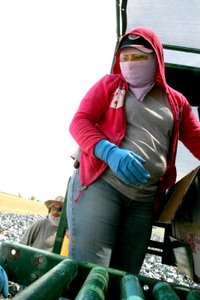 LAMONT, CA - 11JUNE09 - Migrant indigenous Mixtec farm workers from Oaxaca cut and pack cabbage for Grimmway Farms. Copyright David Bacon
LAMONT, CA - 11JUNE09 - Migrant indigenous Mixtec farm workers from Oaxaca cut and pack cabbage for Grimmway Farms. Copyright David BaconAlthough the sample is very small, the women in the ICS earn less and are more poorly treated than men. First, there is a significant advantage in wages for men over women. Well over half the women earned below the minimum while only about one quarter of the men did. They also appear (recall the small sample) to suffer from worse working conditions. Compared to men, they pay more often for their equipment (58% vs. 48%), they pay more often for rides (31% vs. 24%), and more of the women than the men are paid by the piece rather than by the hour (44% vs. 34%)--see Chart 4, below
In sum, although it can be shown that two regions—Santa Rosa and Salinas—pay higher (although still low) wages to indigenous farmworkers, the working conditions in these and other areas are uniformly poor. A slightly higher wage may reflect a sped-up piece-rate-based work environment rather than better conditions for the workers.
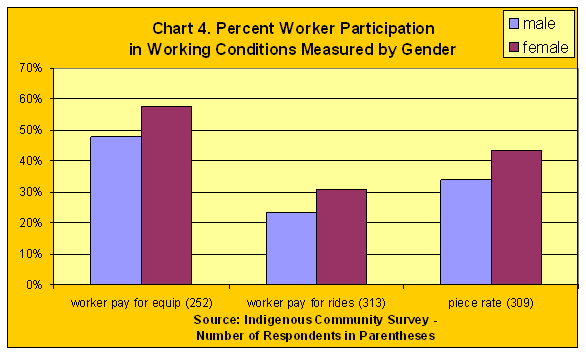
The workers in the Indigenous Community Survey were asked if they would like to make a legal demand regarding the complaints that they have against employers, landlords or others. Just under one in five had a complaint. Most of the legal complaints were related directly to the work site (see Table 1, below).
The biggest complaint was non-payment of wages or being underpaid relative to what the employer had promised before the work began (27%). Several workers complained that the foremen would dock them pay without explanation, or would undercount the boxes (in strawberries) or pounds (in the case of peas) in order to underpay the workers.
Another 15% complained about the working conditions. The workers often mentioned foremen that yelled at the workers or did not provide water or bathrooms in the fields. Another common complaint was having their injuries ignored or their doctors’ bills unpaid by the responsible employer (10%). Several said that foremen refused to take them to the doctor after an injury.
Apart from the workplace, the most common complaint stemmed from an inability to make themselves understood by authority figures in California (25%). The workers complained of accidents that could not be resolved and of fraud they had suffered that they could not find help for. One 47-year-old Mixteco man in Oxnard complained that a money transfer company took his money to send to Mexico but that it never reached the destination. He could not recover his money. Some complained of outright discrimination due to the inability to speak Spanish well. One 60-year-old Triqui-speaking woman in Greenfield complained that the foreman waved her off pretending like he didn’t understand her when she complained in broken Spanish that he was undercounting her pounds picked. Another 54-year–old Triqui in Santa Rosa complained that other workers and foremen made fun of his Spanish language skills humiliating him in front of other workers.
| Table 1. Legal Complaints by Workers | ||
| Type of complaint | Percent | |
| Underpaid or not paid at all | 28.8% | |
| Discrimination and inability to complain due to language barriers | 25.4% | |
| Poor working conditions | 15.3% | |
| Foreman Ignored an injury or illness | 10.2% | |
| Abuse by a Landlord or Merchant | 10.2% | |
| A Problem with the Police | 3.4% | |
| Other Problem | 6.8% | |
| Source: Indigenous Community Survey -- 59 Complaints |
||